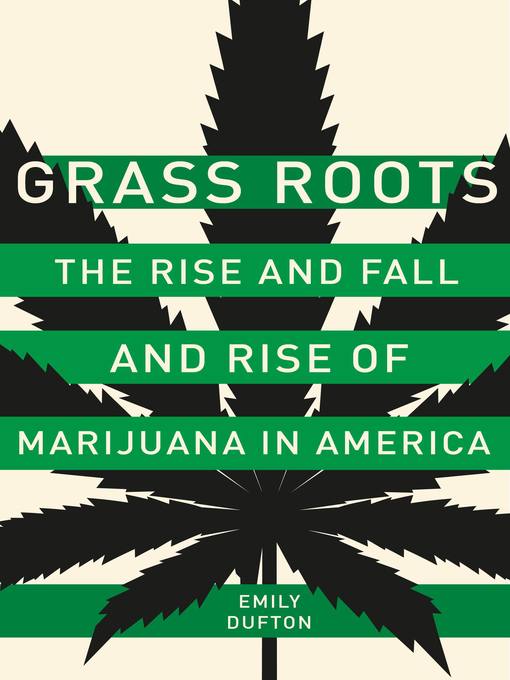
Grass Roots
The Rise and Fall and Rise of Marijuana in America
کتاب های مرتبط
- اطلاعات
- نقد و بررسی
- دیدگاه کاربران
نقد و بررسی

October 9, 2017
Chronicling the movements for and against marijuana legalization in the U.S. from 1964 to the 21st century, American-studies scholar Dufton argues that grassroots activism and local organizing, rather than politician-led action, have had the most influence on marijuana-policy shifts. Though federal prohibition persists, nearly 70 million Americans live in states where cannabis is either medically or recreationally available. Dufton shows that getting to this situation was far from straightforward. Advocacy groups, including the National Organization for the Reform of Marijuana Laws, and individual activists emerged from the 1960s counterculture to make startling gains; by 1978, seven states had decriminalized possession. But responding to spikes in adolescent use, organized groups of concerned parents successfully pressured lawmakers to revoke these laws and gained sympathy from the fiercely antidrug Reagan administration. Antidrug momentum was blunted as cannabis’s medical applications became more widely known and Californians passed the nation’s first medical marijuana law by a 1996 ballot initiative. Current legalization efforts center on outrage over “racist arrest rates,” prospective economic benefits, and the fact that “millions of Americans continue to smoke pot.” Dufton makes a potent argument that, “more than any other legal or illegal substance, marijuana is a drug that makes people care.” Agent: Rayhane Sanders, Massie & McQuilkin Literary.

November 1, 2017
A comprehensive history of marijuana legalization in America.In a book based on doctoral dissertation research on marijuana activism, writer and drug historian Dufton puts years of dedicated research, interviews, and social scrutiny to impressive use in this cannabis saga. Aside from a wealth of factual data, the legalization activists' movement supports the framework of her chronicle. The author charts the roots of the marijuana movement back to the mid-1960s when a San Francisco-based grass-roots cannabis activist "politely asked to be arrested for smoking pot," an offense that happened to be a felony in California at the time. His action, and its ensuing media coverage, spurred countless others to take up the cause and fight for change. The battle, spearheaded in part by poet Allen Ginsberg, became a fiercely political movement, with marijuana activists asserting that the current legislation was unconstitutional. Dufton notes that it was the organization and mobilization of pot advocates and their spirited rallies that turned the tide on the drug's journey toward acceptance and normalization. With the 1970 formation of pro-marijuana group NORML and major decriminalization efforts celebrating great strides, marijuana activists were too euphoric to foresee the fearful, parent-fueled counterrevolution spearheaded by Nancy Reagan. The author's astute, well-rounded report spotlights the virtual tug of war of the movement and pays close attention to each side's setbacks and advancements. She presents an engrossing, evenhanded timeline of the marijuana legalization revolution and its backlash, including the 2012 legalization laws inspired by Robert Randall, who sued on a medical necessity defense after being arrested for possession. The final section, drawn from Dufton's numerous interviews in the field, highlights six crucial lessons activists learned from their experiences promoting marijuana rights, including keeping a sensible perspective on the movement's progress, respecting the opposition, and recognizing the power and the importance of money. The author hopes emphasizing these positives and pitfalls will galvanize future advocates in their work.A lively, perceptive refresher course on the politics of pot.
COPYRIGHT(2017) Kirkus Reviews, ALL RIGHTS RESERVED.

December 1, 2017
Dufton's balanced and thoroughly researched book traces the long and still unwinding history of marijuana policy and activism in the U.S. In the late 1800s, pot was used legally in pain-relieving tinctures, but by 1937, all forms became illegal. This drove marijuana underground, where it enjoyed cult status and remained broadly available, surfacing as the symbol of the 1960s counterculture. Moving forward, pro-marijuana groups, including the still-active NORML, lobbied state and federal governments with some notable successes, but soon the path was blocked by what Dufton says was effective lobbying by parent groups, who found Ronald and Nancy Reagan receptive to their cause. More recently, the emphasis has been on medical uses, such as cancer and HIV/AIDS pain relief, and the justice-reform movement, as mass incarceration of black youth was shown to be four to eight times the rate of whites for similar pot-related offenses. Today millions live in states where recreational and medical use is legal, but federal rules have not adjusted, and history shows that political and popular opinion can change unexpectedly. Stay tuned.(Reprinted with permission of Booklist, copyright 2017, American Library Association.)

























دیدگاه کاربران